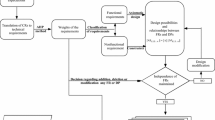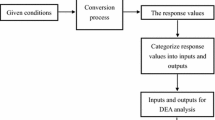Abstract
When it comes to solving engineering design problems, the existing techniques require a significant amount of time. In the following case the objective function value has been obtained using optimization methods which has been the subject of many research efforts, recently accepted methods possess advantages however the biggest challenge is the number of objective functions and constraints required. In this paper, we proposed a novel combined approach involving the method of Data Envelopment Analysis and the Spider’s web initial solution. It turns out that the selected method requires no additional algorithm and can be used to solve most multi-objective problems, in contrast to previous methods in which the number of objective functions increase due to a rising level of complexity in such algorithms thereby leading to a reduction in effectiveness. Furthermore the proposed method is capable of yielding a more efficient result in non-convex problems as well as typical convex problems.









Similar content being viewed by others
References
Arakawa M, Nakayama H, Hagiwara I, Yamakawa H (1998) Multi-objective optimization using adaptive range genetic algorithms with data envelopment analysis. In: A collection of technical papers on 7th symposium on multidisciplinary analysis and optimization (TP98-4970), AIAA, vol 3, pp 2074–2082
Banker RD, Charnes A, Cooper WW (1984) Some models for estimating technical and scale inefficiencies in data envelopment analysis. Manag Sci 30:1078–1092
Bazara MS, Sherali HD, Jarvis JJ (1993) Linear programming and network flow, 4th edn. Wiley
Charnes A, Cooper WW, Rhodes E (1978) Measuring the efficiency of decision making units. Eur J Oper Res 2:429–444
Dias AHF, de Vasconcelos JA (2002) Multi-objective genetic algorithms applied to solve optimization problem. IEEE Trans Magn 38(2):1133–1136
Fonseca CM, Fleming PJ (1993) Genetic algorithms for multi-objective optimization: formulation, discussion and generalization. In: Proceedings of the 5th international conference on genetic algorithms, pp 416–426
Goldberg DE (1989) Genetic algorithms in search optimization and machine learning. Addison-Wesley, Reading
Lin R, Sir MY, Pasupathy KS (2013) Multi-objective simulation optimization using data envelopment analysis and genetic algorithm: specific application to determining optimal resource levels in surgical services. Omega 41:881–892
Liu F-HF, Huang C-C, Yen Y-L (2000) Using DEA to obtain efficient solutions for multi-objective 0–1 linear programs. Eur J Oper Res 126:51–68
Parvizi M, Shadkam E, Jahani N (2015) A hybrid coa/ε-constraint method for solving multi-objective problems. Int J Found Comput Sci Technol 5(5):27–40
Sawaragi Y, Nakayama H, Tanino T (1985) Theory of multi-objective optimization. Academic Press, Cambridge
Schafer JD (1985) Multiple objective optimization with vector evaluated genetic algorithms. In: Proceedings of the 1st international conference on genetic algorithms, pp 93–100
Tamaki H, Kita H, Kobayashi S (1996) Multi-objective optimization by genetic algorithms: a review. In: Proceedings of the ICEC’96, pp 517–522
Tulkens H (1993) On FDH efficiency: some methodological issues and applications to retail banking, courts, and urban transit. J Prod Anal 4:183–210
Yougbare JW, Teghem J (2007) Relationship between Pareto optimality in multi-objective 0–1 linear programming and DEA efficiency. Eur J Oper Res 183:608–617
Yun Y, Nakayama H (2013) Utilizing expected improvement and generalized data envelopment analysis in multi-objective genetic algorithms. J Glob Optim 57:367–384
Yun YB, Nakayama H, Tanino T (1999) A generalization of DEA model. J Soc Instrum Control Eng (SICE) 35:1813–1818
Yun YB, Nakayama H, Tanino T, Arakawa M (2001) Generation of efficient Frontiers in multi-objective optimization problems by generalized data envelopment analysis. Eur J Oper Res 129:586–595
Yun Y, Nakayama H, Arakawa M (2004) Multiple criteria decision making with generalized DEA and an aspiration level method. Eur J Oper Res 158:697–706
Acknowledgments
Funding was provided by Payame Noor University (Grant No. 1).
Author information
Authors and Affiliations
Corresponding author
Rights and permissions
About this article
Cite this article
Ranjbar, K., Khaloozadeh, H. & Heydari, A. A novel mixed Spider’s web initial solution and data envelopment analysis for solving multi-objective optimization problems. Cent Eur J Oper Res 28, 193–208 (2020). https://doi.org/10.1007/s10100-018-0566-3
Published:
Issue Date:
DOI: https://doi.org/10.1007/s10100-018-0566-3




